Tycho Brahe (1546-1601)
Born on December 14, 1546 in Knudstrup, Denmark, of noble descent, Tycho [Tyge] Brahe was probably the greatest pre-telescopic astronomer. He was sent by his family to study in Copenhagen, then to Leipzig to study law, but he soon became entirely occupied with astronomy. In 1565 and 1566 Tycho studied mathematics at the universities in Wittenburg and Rostock. It is in Rostock that Tycho engaged in a duel with a fellow student and nobleman that ended up costing him part of his nose.
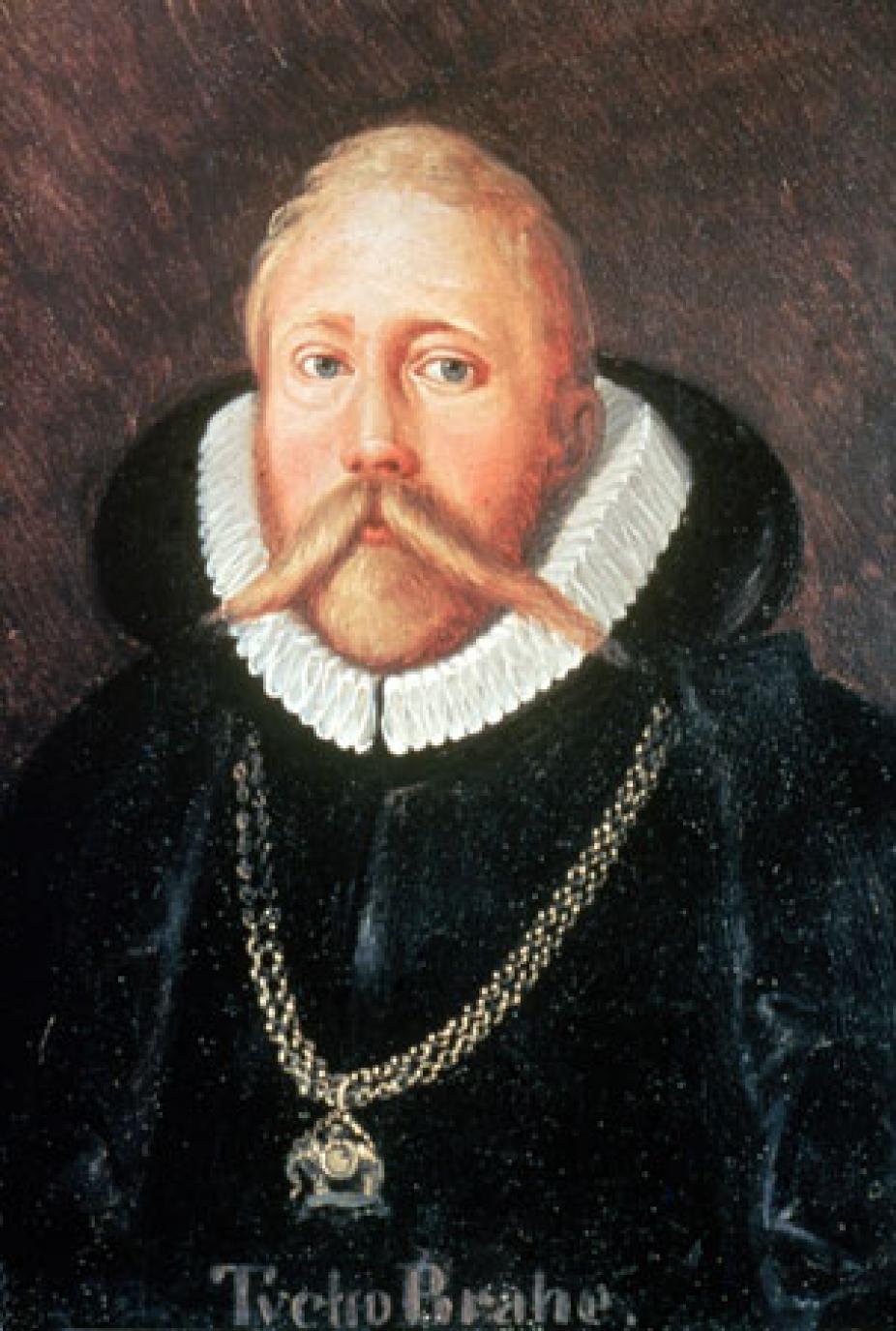
Painting of Tycho Brahe
http://en.wikipedia.org/wiki/Tycho_Brahe
Tycho's reputation as an accomplished astronomer rose quickly, primarily through his observations of and writings on the 1572 novae in Cassiopea, and of the 1577 comet. Tycho demonstrated, perhaps more convincingly than anyone before him, the falsity of the Aristotelian doctrine of the immutability of the Heavens, and of the Aristotelian theory of comets as an atmospheric phenomenon taking place in the sublunar sphere.
On May 23, 1576, the Danish King Frederick II granted Tycho the island of Hven, east of Copenhagen, by royal decree and an annual stipend to further his astronomical research. Tycho used his independence and financial security to establish the Uraniborg Observatory on the island.
Tycho proceeded to build astronomical measuring instruments of unprecedented accuracy, not to mention physical size. He also established his own printing press on Hven, and built a second underground observatory with isolated observing stations to ensure reliably independent multiple astronomical measurements.
Tycho was convinced of the falsity of the Ptolemaic/Aristotelian planetary model. Objecting to Ptolemy's model of planetary motion, and unable to detect the annual parallax of the fixed stars predicted by the Copernican model, he rejected the latter as well. As a compromise, he proposed the "Tychonian Planetary Model," in which the Earth is at the center of the universe, the Sun orbits the Earth, but all other planets orbit the Sun. From the point of view of planetary motions, this yields predictions identical to those of the Copernican Model without requiring annual stellar parallax.
>One of Tycho's most impressive astronomical achievements was his discovery of the Moon's so-called annual variation, a variation of the Moon's orbital speed associated with the gravitational pull of the Sun, which shows a yearly pattern due to the slightly varying distance between the Earth and Sun over the course of the year. He also determined the length of the year to an accuracy of a few seconds.
Upon losing royal support in Denmark, Tycho moved to Prague and in 1598 was appointed Imperial Mathematician to the Holy Roman Emperor Rudolf II. His astronomical research program never really resumed, however. He died in Prague on October 14, 1601, leaving his most recent assistant Johannes Kepler as his scientific heir.
Bibliography
Dreyer, J.L.E., 1890, Tycho Brahe, [Dover Reprint 1963].
Thoren, V.E. 1989, Tycho Brahe, in The General History of Astronomy, vol. 2A, eds. R. Taton and C. Wilson, Cambridge University Press, pps. 3–21.
Thoren, V.E. 1990, The Lord of Uraniborg. A Biography of Tycho Brahe, Cambridge University Press.
Tycho Brahe's Observations and Instruments
Tycho's observations of stellar and planetary positions were noteworthy both for their accuracy and quantity. His celestial positions were much more accurate than those of any predecessor or contemporary. Tycho was not a Copernican, but proposed a "geo-heliocentric" system in which the Sun and Moon orbited the Earth, while the other planets orbited the Sun. Although Tycho's planetary model was soon discredited, his astronomical observations were an essential contribution to the scientific revolution.
1572 NOVAE

1572 (super)nova.
Shown is a diagram in Tycho Brahe's 1573 book, "De Nova Stella", showing the position of the 1572 (super) nova with respect to the bright stars in the constellation Cassiopea. A lack of detectable parallax forced Brahe to locate the nova beyond the sphere of the Moon, i.e., in the celestial realm, supposedly unalterable according to Aristotelian doctrine.
1577 Comet and Orbital Reconstruction
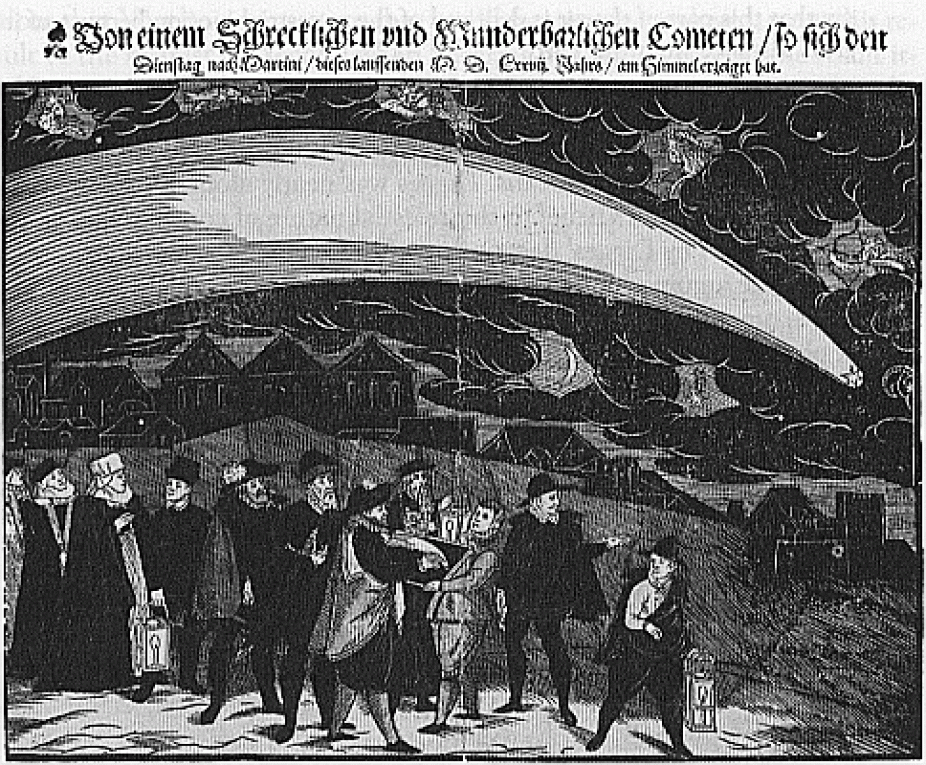
The 1577 comet.
Shown here is a depiction of the 1577 comet observed by Tycho, which remained visible from November 1577 to January 1578. His observations revealed no measurable parallax, implying that the comet was located beyond the sphere of the moon.
His reconstruction of the comet's orbital path, from brightening and dimming and displacement with respect to the background stars, indicated that the comet moved across the concentric planetary crystalline spheres. This supported the notion of a "fluid heaven" and contradicted the physical reality of these spheres as real, hard, transparent, and contiguous spherical shells.
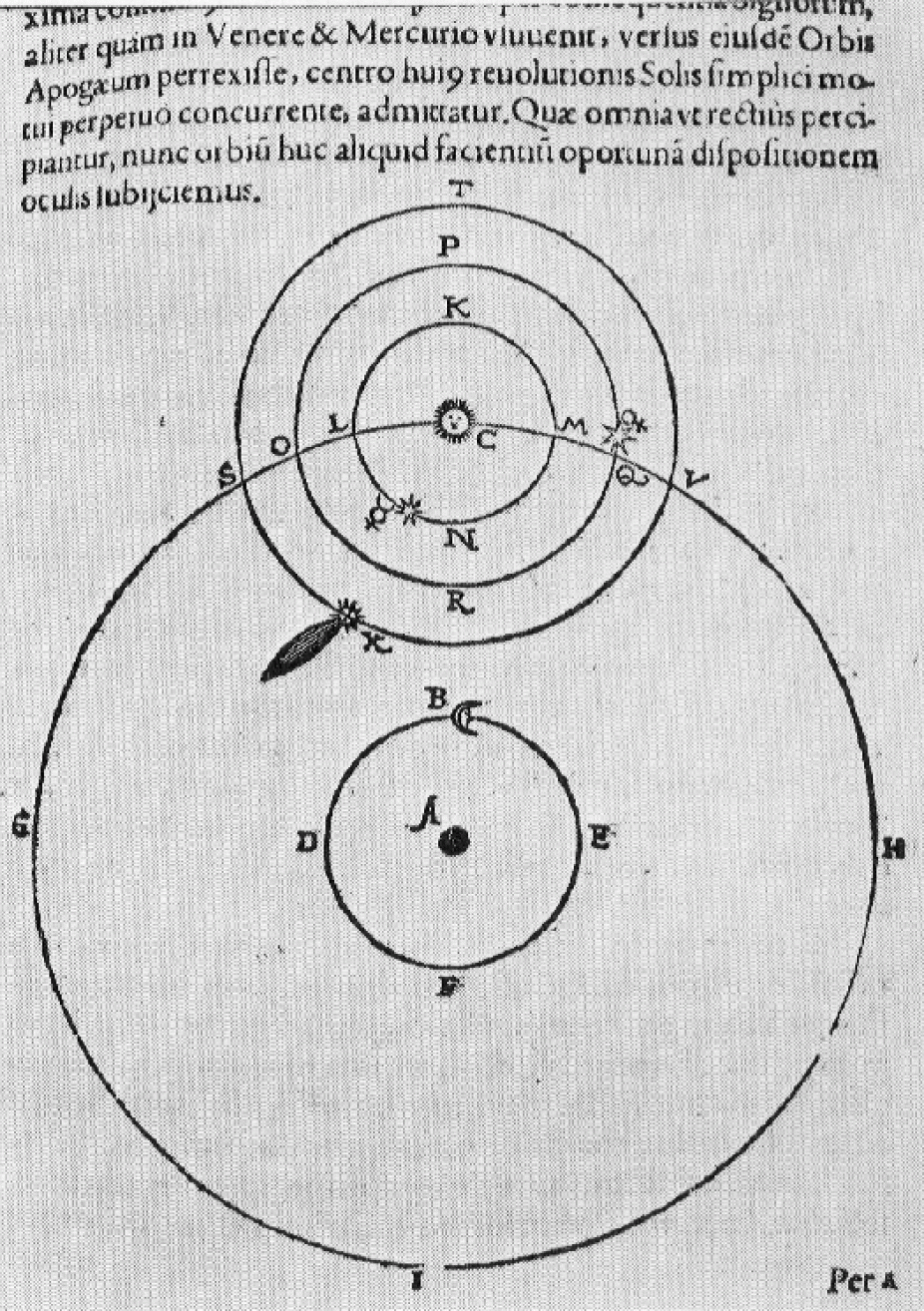
Orbital path of 1577 comet.
The comet's path is drawn within Tycho's planetary system, where all planets orbit around the Sun, with the latter orbiting a fixed Earth. Note that the comet's path crosses numerous planetary spheres, from which Tycho concluded that the said spheres could not be crystalline, solid objects as assumed by Aristotle. Like Nicolaus Copernicus and other earlier astronomers, Tycho clung firmly to the notion of perfectly circular orbits for all heavenly bodies; Johannes Kepler would be the first to break from this particular theory.
The Tychonian Planetary Model
The Tychonian planetary model, conceived by Tycho around 1583, was an unconvincing attempt to reintroduce geocentrism in the "Copernican planetary system." From his observations of the 1572 (super)nova and 1577 comet, Tycho was convinced of the falsity of the Ptolemaic system. In Tycho's system the Earth is absolutely fixed, so that the daily motion of the fixed stars is ascribed to a daily rotation of the outermost sphere, as in the Ptolemaic system. A similar planetary system was proposed in antiquity by Heraklides of Pontus (ca. 388–310 BC)who, however, ascribed to the Earth a daily axial rotation.
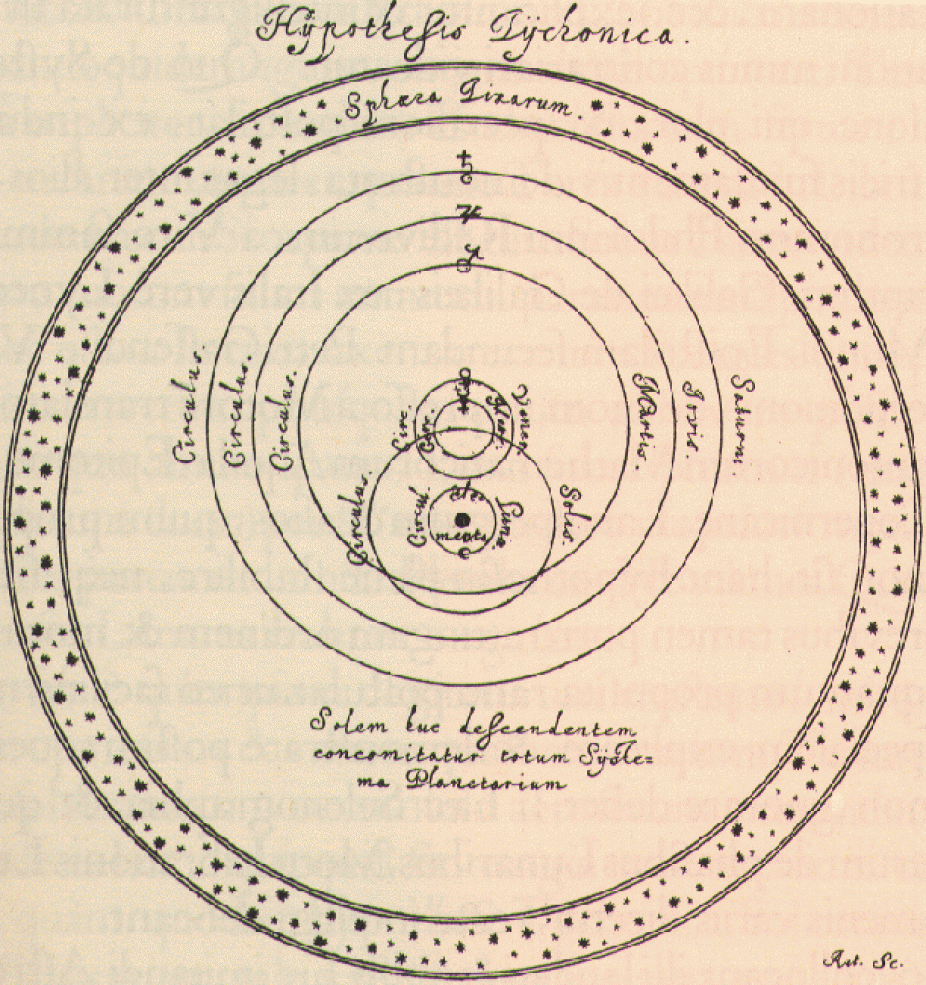
1583 Tychonian planetary model.
From the standpoint of apparent planetary motions as seen from Earth, this system is observationally indistinguishable from the Copernican model, yet maintains the fixity of the Earth. The latter belief was held by Tycho to the end of his life, largely because he had been unable to detect the annual parallax of the fixed stars predicted by the Copernican model, despite the unprecedented accuracy of the observations carried out with his "giant instruments" at Uraniborg. Tycho could measure parallax down to 2 minutes of arc (1/30 of a degree); his lack of parallax detection for fixed stars implied that the latter would have to be located 700 times farther away than Saturn, the outermost planet known at the time.
Tycho's Instruments
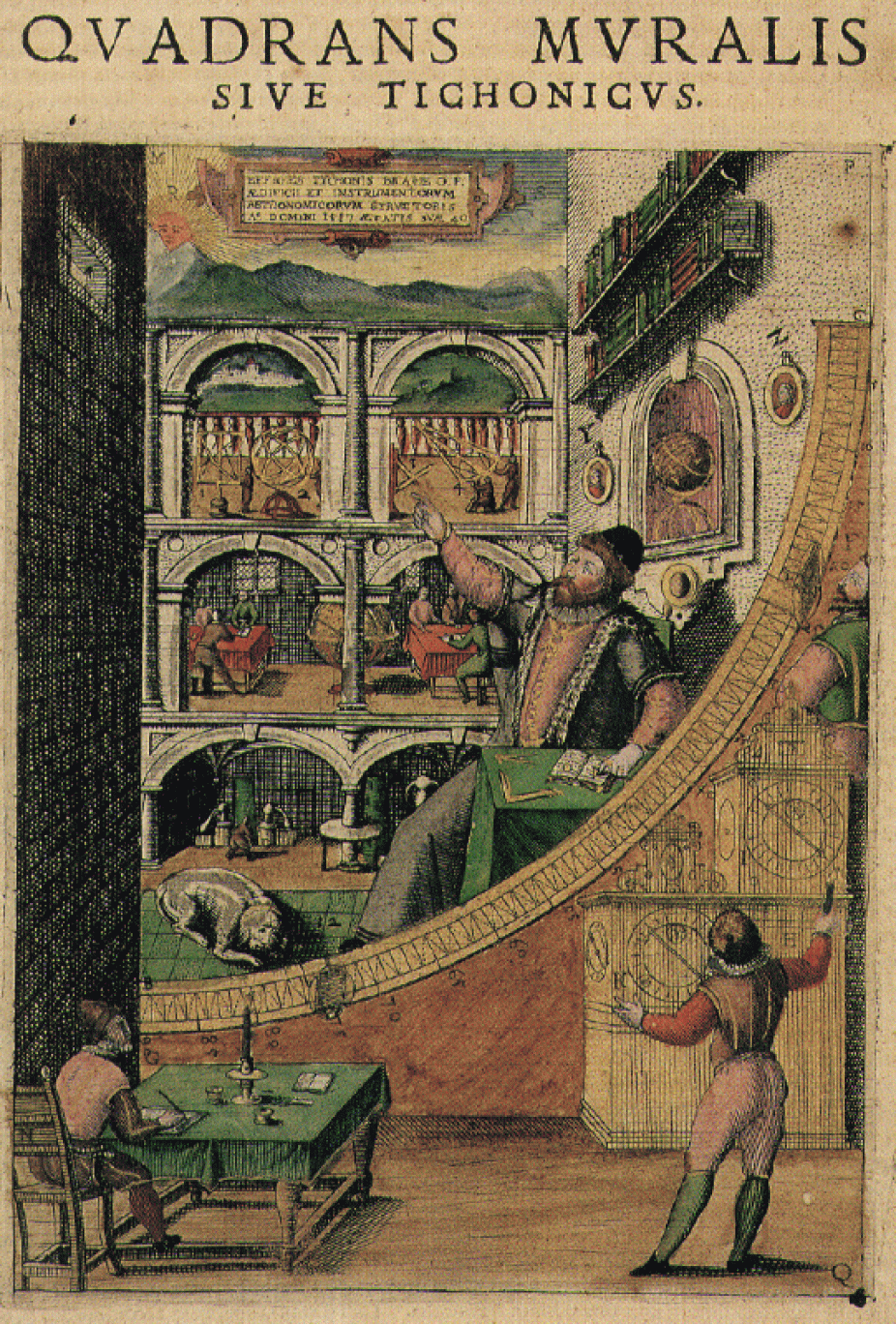
1598 tinted engraving from Tycho's "Astronomiae instaurata mechanica".
Uraniborg was a Danish astronomical observatory and alchemical laboratory established and operated by Tycho Brahe. It was built from 1576–1580 on Hven, an island in the Øresund between Zealand and Scania, which at that time was part of Denmark. Uraniborg was the first custom-built observatory in modern Europe, though not the last to be built without a telescope as its primary instrument. The observatory had a large mural quadrant affixed to a north-south wall, used to measure the altitude of stars as they passed the meridian. This, along with many other instruments of the observatory, was depicted and described in detail in Brahe's 1598 book "Astronomiae instaurata mechanica" (tinted engraving.)
1576 Brass Azimuthal Quadrant
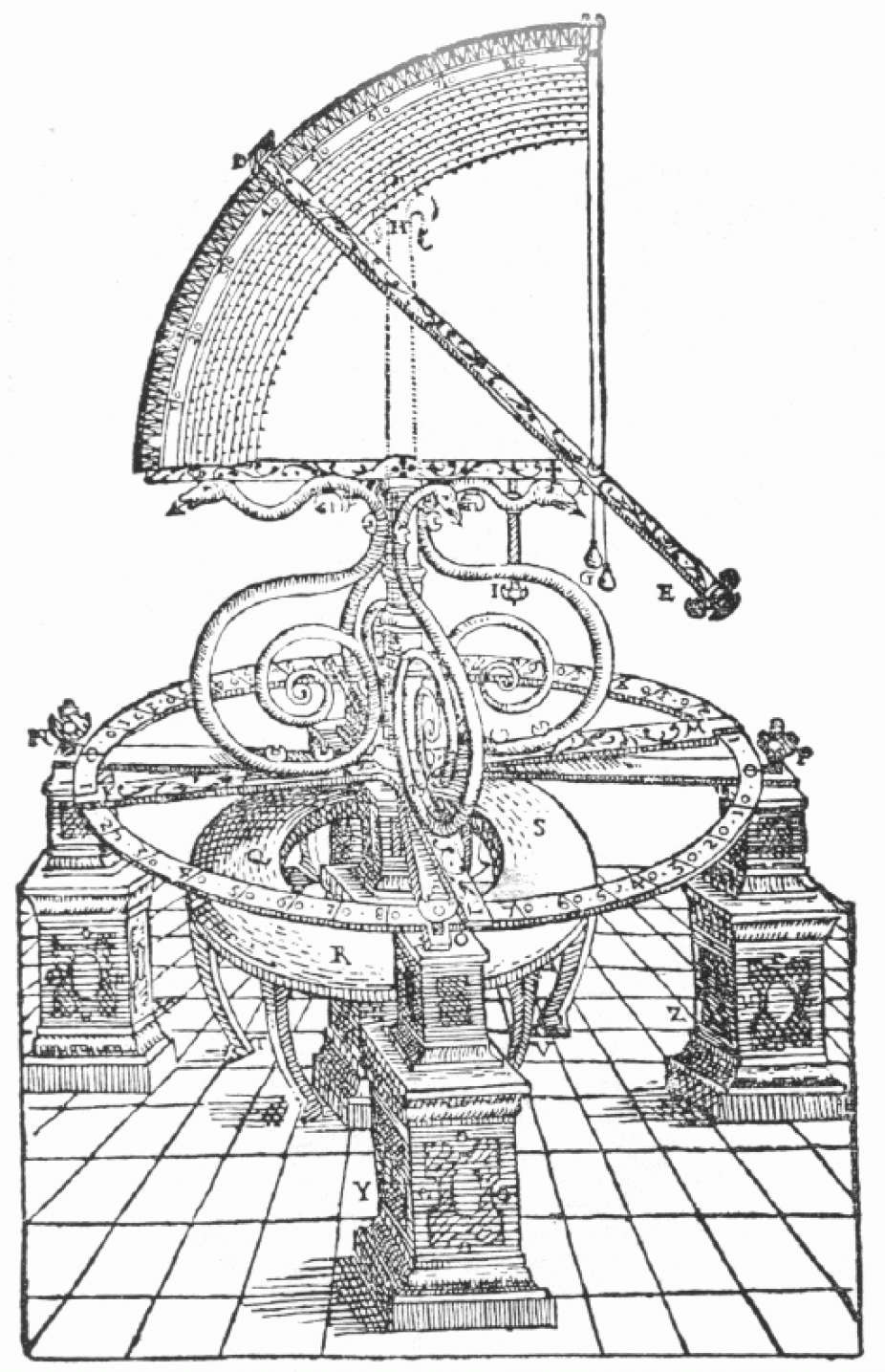
1576 brass azimuthal quadrant.
Tycho's brass azimuthal quadrant, 65 centimeters in radius, was built in 1576 or 1577. It was one of the first instruments built at Hveen, and was used for observations of the 1577 comet. It had a estimated accuracy of 48.8 seconds of arc.
1580 Great Globe

The great globe.
Tycho's great globe, about 1.6 meter in radius, was over 10 years in the making. This instrument came in service in late 1580. Most of the work involved making the hollow wooden globe as perfectly spherical as possible, after which it was covered in brass plates.
The globe had two primary scientific uses; it came to be used to record the position of stars observed by Tycho. By 1595 he had 1000 accurately observed stars inscribed on the globe. However, it was originally intended as a computational device. By means of auxiliary circles, the local azimuth/altitude coordinates, as measured with Tycho's instruments, were converted into the conventional celestial coordinates used to record stellar and planetary positions.
1581 Armillary Sphere
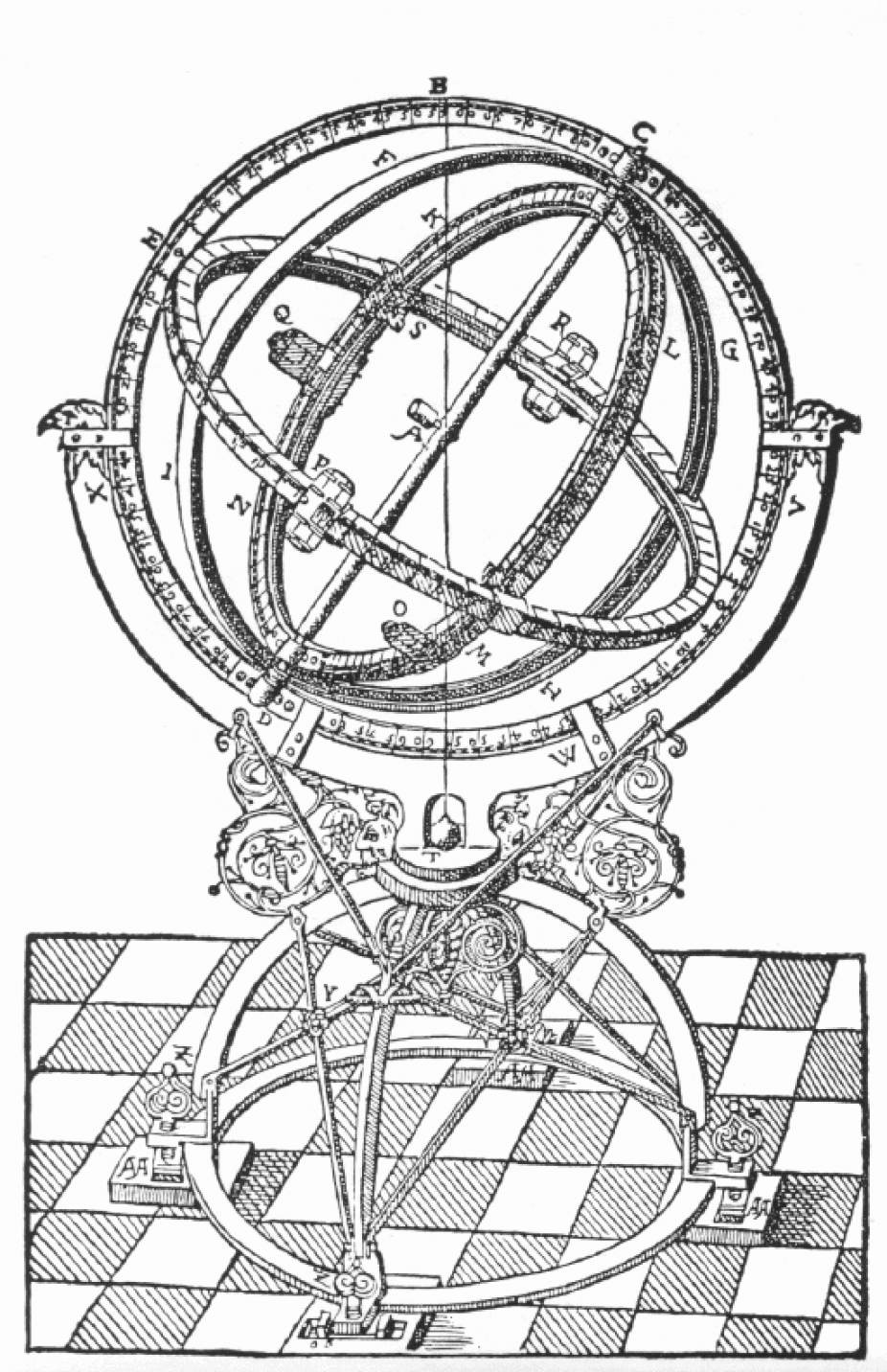
1581 armillary sphere.
An "armillary sphere" is a model of objects in the sky (in the celestial sphere), consisting of a spherical framework of rings, centered on Earth, that represent lines of celestial longitude and latitude and other astronomically important features such as the ecliptic. As such, it differs from a celestial globe, which is a smooth sphere whose principal purpose is to map the constellations.
Tycho's armillary sphere was 1.6 meter in radius and built in 1581. Tycho rapidly gave up on using large versions of the classical armillary sphere, as he found their accuracy compromised by flexing and bending due to the great weight of the various components. This lead to the design of the vastly superior equatorial armillaries.
1582 Triangular Sextant
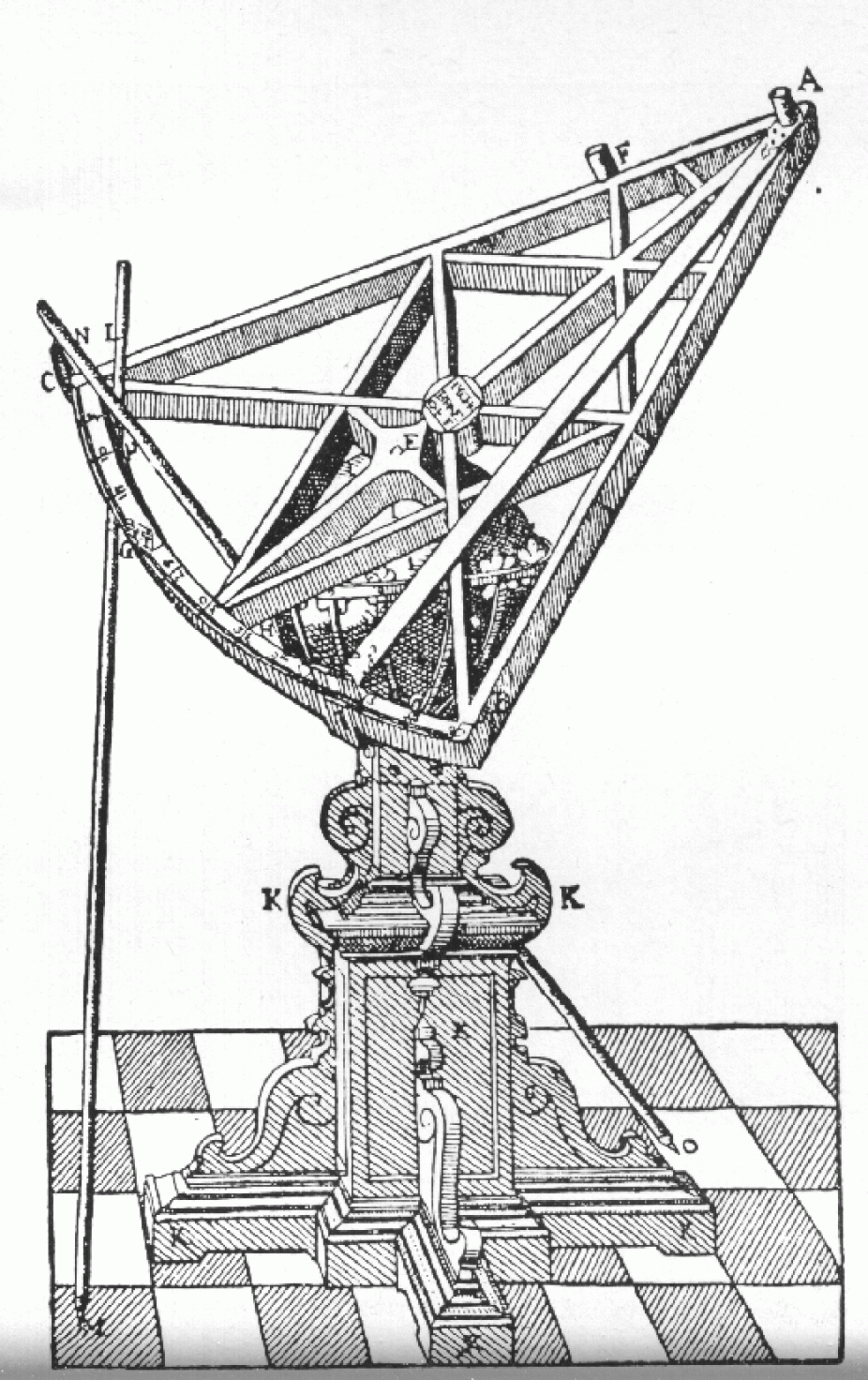
1582 triangular sextant.
Tycho's triangular Sextant, about 1.6 meter in radius, was built in 1582. As Tycho's sextants grew in size, they became fixed instruments, although Tycho's ingenious globe mount retained a lot of the versatility of use of smaller, conventional portable sextants.
1585 Great Equatorial Armillary

1585 great equatorial armillary.
Large instruments such as these, with improved sighting devices and measuring scales, as well as Tycho's advanced procedures to correct for atmospheric refraction, allowed him to compute stellar and planetary positions consistently accurate to within a minute of arc. Tycho's determination of the tropical year was too small by about one second, and his determination of the Earth's orbital tilt (which Tycho, committed to the Earth's fixity as he was, referred to as the angle between the ecliptic and the celestial equator) by half a minute of arc.
Tycho's great equatorial armillary, 3 meters in diameter, was built in 1585. This is an armillary sphere reduced to its bare essentials, and one of Tycho's workhorse instruments. It has an estimated accuracy of 38.6 seconds of arc.
1586 Revolving Wooden Quadrant
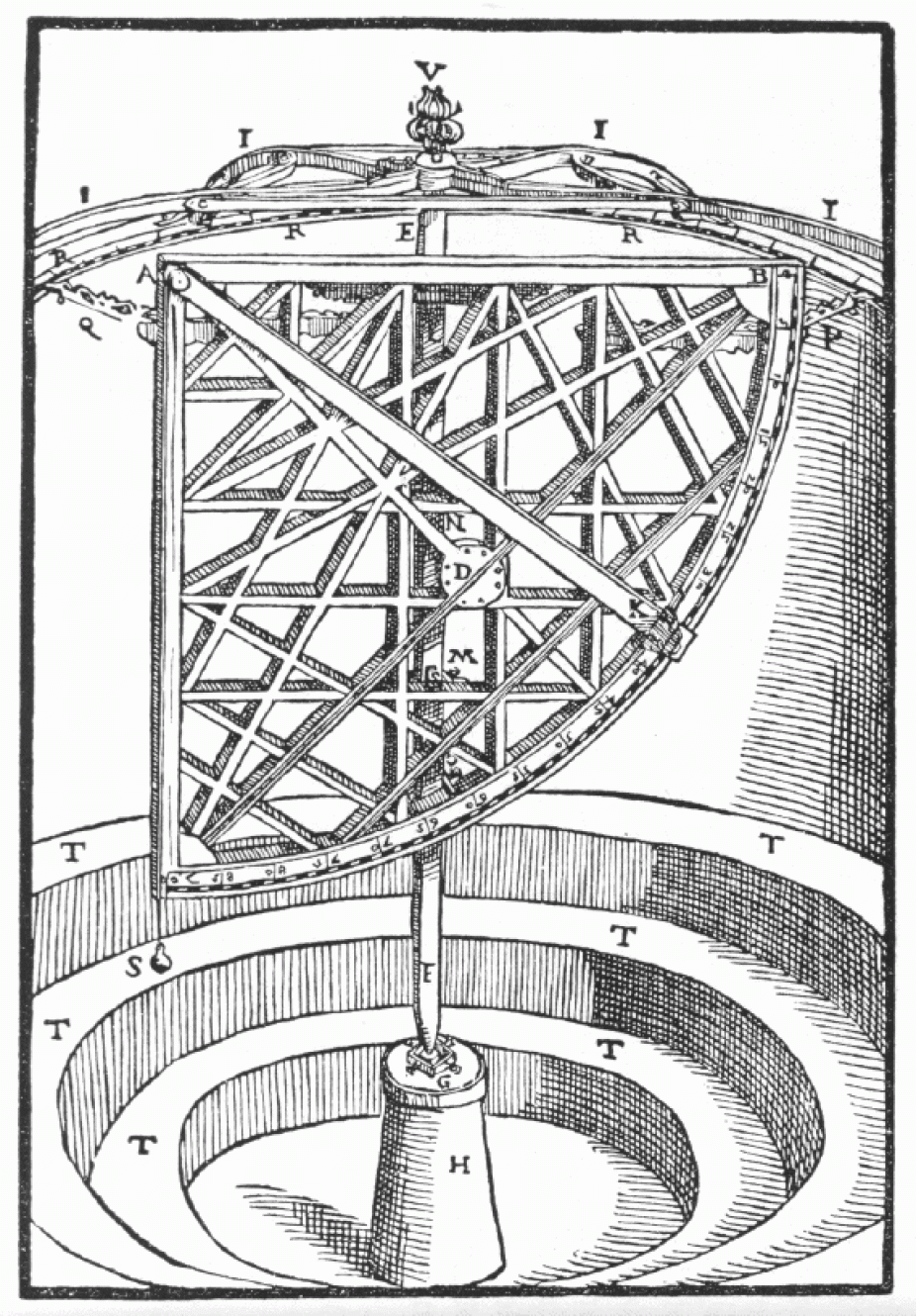
1586 revolving wooden quadrant.
Tycho's revolving wooden quadrant, 1.6 meter in radius, was built in 1586. It had an estimated accuracy of 32.3 seconds of arc, based on eight reference stars.
1588 Revolving Steel Quadrant
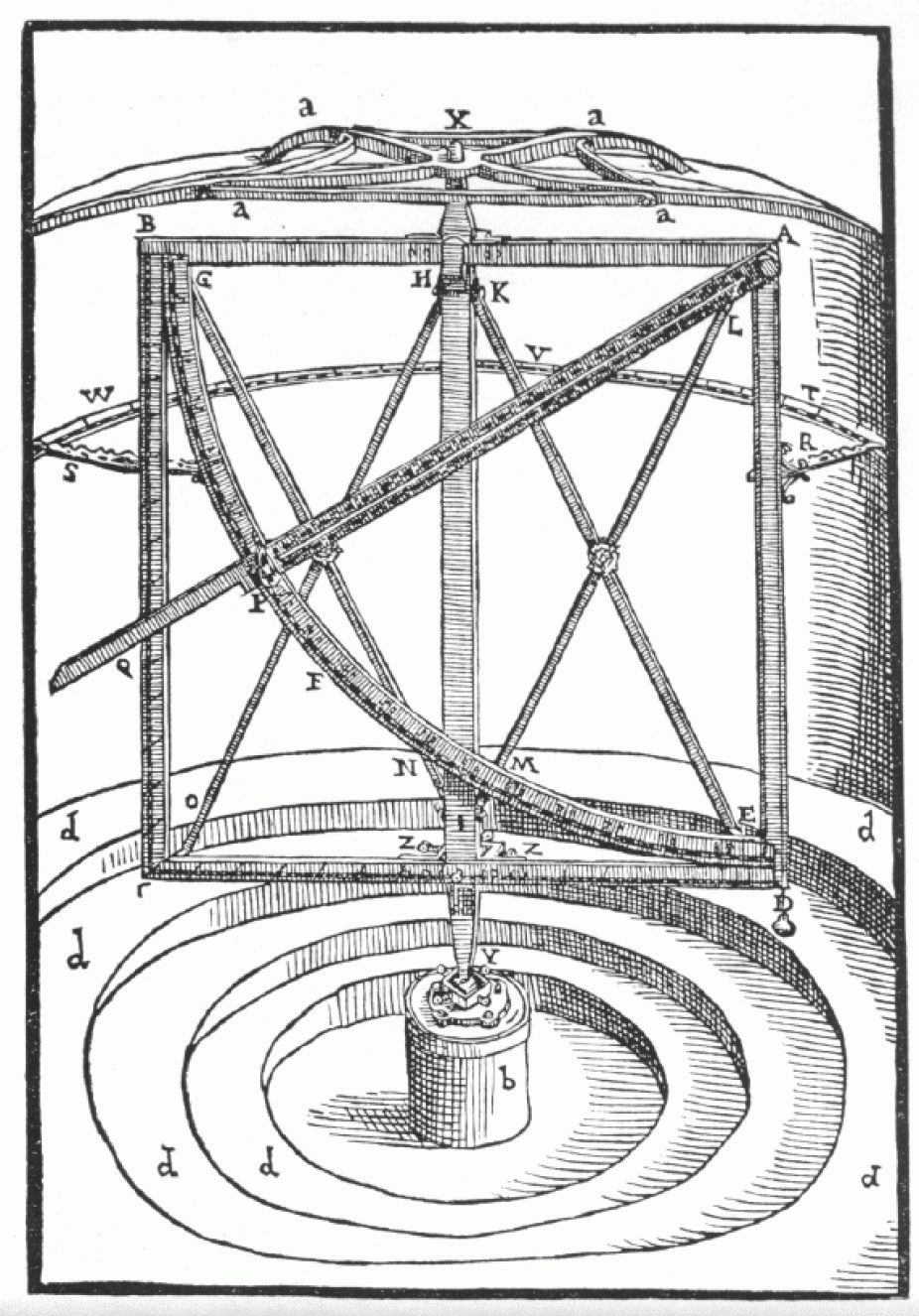
1588 revolving steel quadrant.
An improvement over Tycho's wooden version, his revolving steel quadrant, 2 meters in radius, was built in 1588. It's estimated accuracy was 36.3 seconds of arc.
Tycho left Hveen in 1597, having fallen out of favor with the Danish King Christian IV. Upon settling in Prague he arranged for most of his instrument to be shipped there. After his death, legal battles between Kepler and Tycho's heir led to the instruments being stored away. All but Tycho's great globe were destroyed in the aftermath of the Bohemian civil war of 1619. The great globe found its way back to Copenhagen, and remained in the University's observatory tower until that tower and all its content were destroyed by fire in 1728. All we know from Tycho's instruments is from his (fortunately elaborate) published writings.
Bibliography
Thoren, V.E. 1973, Journal for the History of Astronomy, 4, 25.
Wesley, W.G. 1978, Journal for the History of Astronomy, 9, 42.